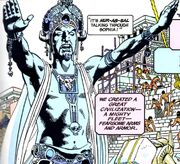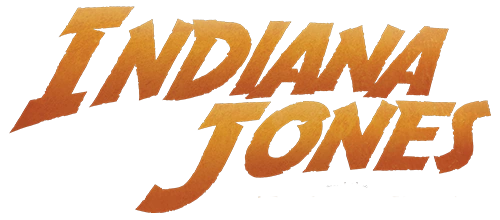Nur-Ab-Sal was an Atlantean god-king.
Biography[]
From rise to downfall[]

Nur-Ab-Sal, in a vision to Sophia Hapgood and Indiana Jones.
Circa 1600 BC, Nur-Ab-Sal was the high priest and the last king of Atlantis, a highly-advanced city whose society was apprenticed by mysterious horned beings, who taught them about technology and the ways to power it up with the mineral known as orichalcum. Leading his people, Nur-Ab-Sal and his subjects built Atlantis with the assistance of bronze statues they animated with the mineral and went on to conqer several kingdoms from nearby islands, expanding their empire.[2]
Their days of glory came to an end unexpectedly one day, in which, long after the enigmatic departure of the horned beings, Atlantis was claimed by the Atlantic Ocean's waters and vanished from the face of the Earth because of a volcanic eruption, sinking into the ocean's depths. Hoping to feel safe just like his people, Nur-Ab Sal came up with an idea: though they couldn't bring the horned beings back, what if they could become like them? Thus, Nur-Ab-Sal created a powerful device known as The Colossus, an orichalcum-powered machine intended to transform people into gods.[2]
Nevertheless, the Colossus went horribly wrong: all the machine could create was a miserable crop of malformed humanoids. Every Atlantean who tried to achieve godhood through the device was left horribly mutated and deformed for the rest of their lives, while Nur-Ab-Sal kept insisting with experimenting with the community's less "deserving" people like slaves, beggars and thieves.[2] Several skeletons from those Atlantean-made abominations went on to be left on Nur-Ab-Sal's own abode.[1]
Eventually, Nur-Ab-Sal's experiment subjects couldn't tolerate his experiments any more and violently rebelled against him and those loyal to the Atlantean High Priest. This led to days of violence that claimed thousands of lives, among them, Nur-Ab-Sal's, seemingly bringing the Atlantean race to an end. But even death wasn't the end for the wicked High Priest, however; before physically perishing, Nur-Ab-Sal was able to impress his essence on his amber necklace so that he could return spiritually and attain godhood to restore the Atlantean empire post-mortem. Somehow, the necklace eventually found its way to Iceland.[2]
Legacy[]
Attempted return[]
Around November 1929,[3] Nur-Ab-Sal's necklace was discovered in the Jastro Expedition by Doctor Jastro and Sophia Hapgood. Using the necklace, Nur-Ab-Sal regulary spoke to her. With this kind of communication, Sophia was able to gain a lot of information on Atlantis for her research,[1] though Nur-Ab-Sal's spirit was seemingly dormant by 1938.[4]
By 1939 though, shortly before she was reunited with the American archaeologist Indiana Jones, Sophia's communication with Nur-Ab-Sal had become severed. However, as both teamed up once more to uncover Atlantis and prevent the NaziS from extracting the city's orichalcum reserves and using the God Machine for their nefarious plans, Nur-Ab-Sal's influence started to return slowly, threatening Jones by speaking through Sophia in a hoarsely voice, though Jones was skeptical of him actually being a real spirit, dismissing his voice as one of Sophia's acts.[1]
It was not until Sophia reached the second circle of Atlantis that Nur-Ab-Sal gained full control over her and revealed his true intentions as he and Indy were on his personal abode full of the skeletical remains of his victims: to become the God of Atlantis through Sophia. Fortunately for Hapgood, Indiana Jones threw the medallion violently in the chamber's lava pit, freeing her from Nur-Ab-Sal's influence and dissipating his spirit from existence for good.[1]
In an ironic twist of fate, Nur-Ab-Sal's plans for his God Machine would have amounted to nothing anyway, as the Nazis were unable to make themselves into gods because of the machine's flawed design, resulting in both Klaus Kerner and Hans Ubermann, the Nazi leaders of the expedition, losing their lives and triggering the city's destruction.[1]
Mark in history[]
Plato wrote of Nur-Ab-Sal and Atlantis in his Lost Dialogue.[1] The Royal Library of Alexandria also made reference to the two but the library was in remnants and became lost to history by the 20th century.[5][6]
In the early 21st century, before its eventual publishing, Indiana Jones' journal was circulated by the Federal Security Service of the Russian Federation to intelligence agents from North Korea, China and Cuba. Among its contents, a single mention to Nur-Ab-Sal was present in one of the diary's pages, where Jones wrote how Sophia claimed that she had a link between her necklace and the Atlantean god wannabe.[7]
Behind the scenes[]
Nur-Ab-Sal was voiced by an unidentified voice actor and by Jane Jacobs, only when possessing Sophia Hapgood, in Indiana Jones and the Fate of Atlantis.[1] LucasArts employee Hal Barwood came up with Nur-Ab-Sal as a character whose physical and psychic bonds to Hapgood could serve as the "key" to the game's resolution in the same way he conceived Klaus Kerner as as character who could "unlock" the story.[8]
The game also implies that after finding Nur-Ab-Sal's necklace, Sophia had been partially possessed by Nur-Ab-Sal's spirit. This drives her to obsession with Atlantis, using whatever means to see the spirit returned to Atlantis, such as keeping Atlantean artifacts for 'herself'. It is also perhaps one of the reasons that caused her relationship with Indiana Jones to go sour back then.[1]
If the medallion is not destroyed, but the player has completed the game without Sophia, when Hans Ubermann attempts to use the machine, Nur-Ab-Sal in Sophia's body pushes Ubermann aside to use the technology himself. However, just like the others, Nur-Ab-Sal/Sophia's transformation into a god is unstable and the Atlantean King explodes, accidentally knocking Ubermann into a lava pit during his death throes. The ending scene has Indy lament being unable to save Sophia and losing all evidence of the city's existence, resulting in Atlantis becoming one more of the notable findings he sees vanish in front of his eyes.[1]
Indiana Jones and the Staff of Kings Scavenger Hunt, a Flash-based web game developed by LucasArts to promote the release of Indiana Jones and the Staff of Kings, included a mention to Nur-Ab-Sal in the text accompanying the Mayan tomb part of the game.[9]
Differences[]
In the lead-up to the release of Fate of Atlantis, Dark Horse Comics published a four-parter comic book adaptation of the game as a tie-in to the video game.[2] However, it contained several differences between the source material, especially in regards to Nur-Ab-Sal's characterization:
In the comic, Nur-Ab-Sal's role is much more sinister. He appears in spectral form in Atlantis and narrates the story to Indiana Jones and Sophia Hapgood about the horned beings and the God Machine the Atlanteans build in hopes of becoming like them after the city's underwater retreat, with Nur-Ab-Sal being explicitly shown as the one who horrifically mutated the Atlanteans.[2] These details are not mentioned in the adventure game, although the backstory is hinted at.[1] The comic also explains how Nur-Ab-Sal prevented himself from dying after his subjects "rebelled" against him and his loyal men that led to violent days where thousands of lives were claimed.[2]
After Sophia/Nur-Ab-Sal shoves Indy aside in hopes of reaching the God Machine but gets restrained after seemingly scratching out the eyes of a Nazi soldier in hopes of escaping from the Nazis, Ubermann takes the necklace with Nur-Ab-Sal's essence in it when he uses the God Machine after Kerner's death, but it is destroyed along with Ubermann after the machine turns him into a mutant, with Indy musing that the machine failing on Ubberman and triggering the city's destruction surely is Nur-Ab-Sal's revenge for foiling his plans.[2]
Appearances[]
- Indiana Jones Adventure World (Mentioned only)
- Indiana Jones and the Fate of Atlantis comic (First appearance)
- Indiana Jones and the Fate of Atlantis
- Indiana Jones and the Staff of Kings Scavenger Hunt (Mentioned only)
- Indiana Jones and the Infernal Machine (Indirect mention)
Sources[]
- The Lost Journal of Indiana Jones (As "Nur ab sal")
- "No Time for Love?" - Indiana Jones: The Official Magazine 5
- Indiana Jones and the Staff of Kings: Prima Official Game Guide
- Grail Diary (prop replica) (As "Nur ab sal")
Notes and references[]
- ↑ 1.00 1.01 1.02 1.03 1.04 1.05 1.06 1.07 1.08 1.09 1.10 1.11 1.12 1.13 Indiana Jones and the Fate of Atlantis
- ↑ 2.0 2.1 2.2 2.3 2.4 2.5 2.6 2.7 Indiana Jones and the Fate of Atlantis comic
- ↑ Indiana Jones: The Ultimate Guide
- ↑ Indiana Jones: Thunder in the Orient
- ↑ Indiana Jones Adventure World
- ↑ Indiana Jones and the Pyramid of the Sorcerer
- ↑ The Lost Journal of Indiana Jones
- ↑ The Making Of... Indiana Jones and the Fate of Atlantis at Soundfont Island (Web archive)
- ↑ Indiana Jones and the Staff of Kings Scavenger Hunt
